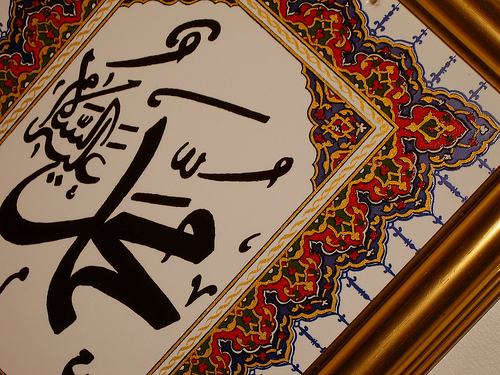
THE WALKING OF SAYYIDINA RASOOLULLAH
The walk of Sayyidina Rasoolullah sallallahu alaihe wasallam has been described in the chapter on the noble features of Sayyidina Rasoolulah sallallahu alaihe wasallam. In this chapter it has been described specifically. The author writes three narrations in this chapter.
HADITH 1
Hazrat Abu Hurairah radiyallahu anhu says, “I did not see anyone more handsome as
Rasoolullah sallallahu alaihe wasallam. It was as if the brightness of the sun had shone from his auspicious face. I did not see anyone walk faster than him, as if the earth folded for him.
A few moments ago he would be here, and then there. We found it difficult to keep pace when we walked with him, and he walked at his normal pace.”
Commentary
That means we could only with effort keep up with his normal pace walking
Hadith Number 2
Ebrahim bin Muhammad says: “When ‘Ali Radiyallahu ‘Anhu described Rasulullah Sallallahu
‘Alayhi Wasallam, he used to say: Rasulullah Sallallahu ‘Alayhi Wasallam walked, he lifted his leg with vigour. He did not drag his feet on the ground like women do. When he walked, because of the speed and force of the legs, it seemed as if he was descending from a high place”.
Commentary
This has been discussed in the chapter on the ‘ Noble features Sayyidina Rasulullah Sallallahu
‘Alayhi Wasallam
Hadith Number 3
Ali bin Abi Taalib Radiyallahu ‘Anhu’ says: “When Rasulullah Sallallahu Alayhi Wasallam
walked he bent slightly forward as if he was descending from a high place”.
Commentary
This has been explained in the previous ahaadith.
CHAPTER ON THE QINAA OF PROPHET

Qinaa is the cloth which Sayyidina Rasoolullah sallallahu alaihe wasallam wore on his
auspicious head under the turban. This was to prevent the turban from becoming oily. The Ulama have also mentioned some other benefits. Only one hadith is mentioned in this chapter.
Hadith Number 1 IN QINAA
Hazrat Anas bin Malik radiyallahu anhu says, “Rasoollullah sallallahu alaihe wasallam often
wore a cloth on his auspicious head. This cloth, because of its greasiness, looked as if had been oiled.”
Hazrat Anas bin Malik radiyallahu anhu says, “Rasoollullah sallallahu alaihe wasallam often
wore a cloth on his auspicious head. This cloth, because of its greasiness, looked as if had been oiled.”
Commentary
That means that the cloth was oily due to the excessive use of oil. Besides all this, it is a
peculiarity of Sayyidina Rasoollullah sallallahu alaihe wasallam that this cloth did not become dirty, nor did any lice live in the clothing of Sayyidina Rasoolullah sallallahu alaihe wasallam, nor could an insect suck his auspicious blood.
Allamah Munaawi has related from (Qari) Allamah Raazi, “A fly never sat on the clothing of Sayyidina Rasoolullah sallallahu alaihe wasallam.”
Sayyidina Rasulullah Sallallahu ‘Alayhi Wasallam’s way of sitting

In this chapter is described the sitting of Sayyidina Rasulullah Salallahu ‘Alayhi Wasallam, and the different postures he adopted. Three ahaadith are mentioned here”.
Hadith Number 1 IN way of sitting
Qaylah bint Makhramah Radiyallahu ‘Anha reports: “I saw Rasulullah Sallallahu ‘Alayhi
Wasallam in the masjid (in a very humble posture) sitting in a qarfasaa posture. Due to his aweinspiring personality, I began shivering’.
Commentary
The ‘ulama differ in the explanation of the word ‘qarfasaa’. The most commonly known is, that while sitting on the ground, to lift both thighs in an upright position, and fold both arms around the legs. It is also termed in the Urdu language as sitting ‘Gowt maar ke’.
The reason for the awe was, that at this moment Sayyidina Rasulullah Sallallahu ‘Alayhi Wasallam was in some deep thought and worry. He never worried over little things. He feared that perhaps a punishment or calamity might descend on the ummah.
This seems to be the hadith that has been mentioned briefly in hadith number twelve in the Chapter on the dressing of Sayyidina Rasulullah Sallallahu ‘Alayhi Wasallam. This hadith has another portion which the author has shortened, where it continues that one among those present, after seeing Sayyiditina Qaylah Radiyallahu ‘Anha shivering said:
‘Oh Rasulullah, this poor woman is trembling’. Sayyiditina Qaylah Radiyallahu ‘Anha says:
‘I was behind Rasuluilah Sallailahu ‘Alayhi Wasallam, and he did not look towards me. He only said: ‘Oh poor woman, be calm’. As soon as Rasulullah Sallallahu ‘Alayhi Wasallam said this all the fear in me vanished’. In some narrations this incident is narrated of a man, as has been mentioned in the chapter on the ‘Dressing of Sayyidina Rasulullah Sallallahu ‘Alayhi Wasallam’.
Hadith Number 2 IN way of sitting
The uncle of ‘Abbaad bin Tamim, ‘Abdullah bin Zayd Radiyallahu ‘Anhu reports: “I have seen
Rasulullah Sallallahu ‘Alayhi Wasallam lying flat on his back in the masjid, with one leg resting on the other.
Commentary
In a narration of Sahih Muslim it has been prohibited to sleep in this manner. The ulma have
summed up both narrations in different ways. A simple explanation is that there are two different postures of sleeping referred to in this manner, both of which have been verified in separate ahadith.
The first is to put the legs flat and rest the one leg on the other. This manner has been
mentioned in the ‘Shamaa-il’, and there is no harm in adopting it. The second manner is to lie with both knees raised, then rest on leg on another. This verifies the narration of Sahih Muslim.
The reason for Sayyidina Rasulullah Sallallahu ‘Alayhi Wasallam prohibiting the second manner is because the lungi was generally worn in ‘Arabia at that time, and it is very likely that the private parts would be exposed in this manner.
It has also been argued here that this hadith is not relevant to the sitting of Sayyidina Rasulullah Sallallahu ‘Alayhi Wasallam.
The ulama give different reasons for this. The simplest one is that in this chapter on sitting, the general meaning of both sitting and lying down is taken, although some of the narrations on lying down will be mentioned in the chapter on sleeping. It may also be possible, as Ibn Hajar has explained, that
this type of sleeping (despite being prohibited in the narration) is permissible in the masjid.
Therefore to sit in different postures should also be permissible.
Hadith Number 3 IN way of sitting
Abu Sa’eed Khudari Radiyallahu ‘Anhu says: “When Rasuluilah Sallallahu ‘Alayhi Wasallam sat
in the rnasjid, he sat in the qarfasaa posture’.
Commentary
By Qarfasaa’ (‘Gowt maar ke’ in Urdu) is meant to sit on the buttocks with both thighs raised, and both arms folded around the thighs. Sometimes instead of the arms a cloth, lungi or a turban is tied around the back, both thighs and legs. This manner of sitting displays humbleness and peacefulness.
For this reason, Sayyidina Rasulullah Sallallahu ‘Alayhi Wasallain many a time sat in this posture. The Sahaabah Radiyallahu ‘Anhum also sat in this manner, but it was not the
object to always sit in this manner.
This does not contradict the narration mentioned in Abu Daawud. from which we gather that Sayyidina Rasulullah Sallallahu ‘Alayhi Wasallarn sat crossed-legged from after fajr till ishraaq (sunrise) in the masjid. It also does not contradict the other ahaadith narrated on this subject.
By sitting in the posture described in the hadith under discussion, besides showing humbleness, one gains rest also. It is said that sitting in a qarfasaa posture is like leaning on a wall for the ‘Arabs. This is because in the wilderness there are no walls to lean upon, therefore this manner of sitting is in place of leaning on a wall. Many a time instead of the hands a cloth was tied around (the body and legs) thus affording more rest.
for prophets stories visit https://sunofislam.com/prophetsofgod/
for scientific miracles articles visit www.sunofislam.com
